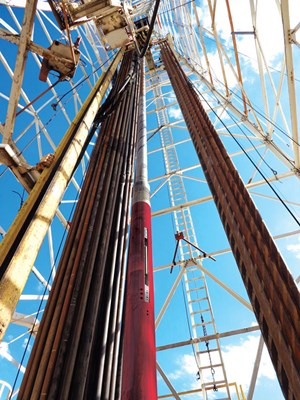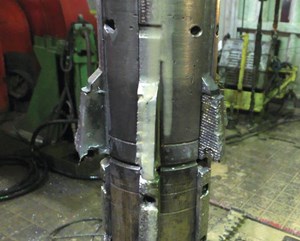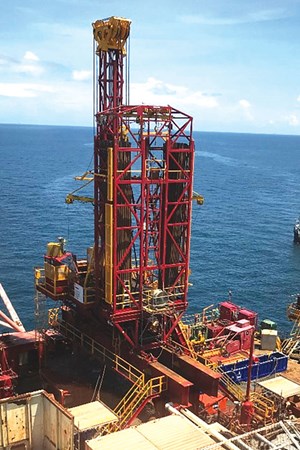Shared values and integrated technologies optimize well abandonment operations
Every well abandonment operation has two fundamental objectives of critical importance. The first is to seal the well by permanently isolating the reservoir without the potential for an unplanned hydrocarbon release. The second is to effectively manage all variables while consistently seeking time- and cost-saving project efficiencies through re-applied learnings, effective communication and technical approaches. The latter objective is particularly challenging when dealing with mature wells that have hidden integrity issues, long histories with multiple operators, or inconsistent information. Of course, wells of any age can present challenges and unknowns to operators, too.
SYNERGIES ADD VALUE
In any well, meeting objectives for compliance standards and abandonment expenditures (APEX) is no easy feat. The right answer involves more than just individual pieces, such as cement or technology. It also requires knowing how to make everything work synergistically. Doing so delivers cost-effective, permanent barriers that mimic the original caprock.
In essence, an effective abandonment project balances the optimization of resources while still enabling a fully compliant outcome. As one example, an abandonment operation may utilize fewer personnel, yet create added value by multi-skilling teams or by removing operational steps with the inclusion of more effective technologies. Additionally, with the application of project-specific commercial and contractual approaches, as well as a complete portfolio of abandonment and slot recovery technologies, this optimization will fully engrain the project values. It also will overarch all other factors in project execution and support finishing responsibly in regard to environmental and financial performance indicators.
TIERED MODELS
According to the preferences of clients, there are three main tiers with varying levels of integration or operator involvement, to deliver solutions for abandonment projects. Choosing the model that best fits the given circumstances of the operator and the project achieves a safe, compliant abandonment to local regulatory and legislative requirements while achieving the lowest total cost of ownership. The delivery models can be grouped as fully integrated, bundled, and alliances. The following sections explain the models and share results delivered by Weatherford Firma well abandonment services, according to each type.
Fully integrated model. The fully integrated model puts the service company in the position of lead contractor. This operator and service company partnership model allows the operator to limit its involvement and share accountability. At the same time, this model ensures that the key aspects of cost control and efficiency are entrenched in all aspects of the team structure, often reinforced by alternative contracting and commercial models. Having one company lead the way in a multi-phase project helps to avoid scope creep, accumulate lessons learned, and demonstrate performance gains from well to well and phase to phase through shared values.
With this integrated model, multi-skilled crews have steadily become the optimal approach, whereby the tasks and roles are focused specifically on the project, and not just oriented around product segments. Although the crew decreases in size, the synergies, knowledge retention, and competence increase. For a customer operating in the Gulf of Mexico, Weatherford acted as a single contractor to manage and engineer a two-phase well abandonment project, using its proprietary pulling unit and the required well services to safely execute incident-free operations, Fig. 1.
In the first phase, the integrated services resulted in the abandonment of 23 wells in 425 days over approximately 102,000 man-hours. The project team set and qualified 59 well barriers and achieved nearly 97% productive time. In the second phase, the services resulted in the abandonment of 58 wells in 911 days over approximately 240,000 man-hours. The project team set and qualified 173 well barriers and achieved 99% productive time.
From front-end engineering through to on-the-project lessons learned, improvements from phase 1 to phase 2 included a 17% reduction in well time, 15% reduction in invisible lost time and 66% increase in qualified well barriers set. These incremental efficiency and productivity gains contributed to a 20% reduction in the authorization for expenditure (AFE) budget. As a result, the operator could then increase the project scope to avoid returning to a third phase and safely undertake final surface well abandonments. The execution led to an additional $8.9 million in savings and delivery 94 days ahead of AFE. Ultimately, the project team fully abandoned 81 wells and installed 232 qualified well barriers with an average 98.4% productive time over 1,336 days.
Bundled services approach. Similar to full integration, the bundled approach utilizes aspects, such as alternative commercial models and multi-skilling at varying degrees, depending on the project structure and extent of services provided. The bundled services approach in this example coordinated activities through a separate integrator, rather than the operator. It let the operator take charge of decisions and split work between different providers for best-in-class services across a project.
On the UK Continental Shelf in the North Sea, a fully integrated well abandonment partner engaged the service company to provide some of its leading services to complement its own in the plugging and abandonment of 13 wells, which included seven oil producers and six gas-injection wells. In addition to managing third-party service partners, the service company assigned a dedicated, experienced project manager to oversee complex and sensitive wellbore preparation, single-trip plug and section milling, casing recovery, and wellbore cleanup services. This solution eliminated a dedicated wellbore conditioning trip prior to milling and deployed cross-trained well abandonment crews to perform a variety of functions.

The Endura single-trip plug and section milling system saved the client 80 hr of critical path time, Fig. 2. The multi-skilled teams helped to significantly reduce personnel on board (POB) over the 13-month scope in one of the most stringently legislated basins in the world. The synergies with the integrator helped the customer to efficiently achieve its asset retirement objectives by delivering the wells 125 days ahead of schedule and at 35% under AFE. The project was executed incident-free and with 98.9% productive time.
Alliance model. The alliance model demonstrates true collaboration between project stakeholders to deliver incident-free operations at the lowest total cost of ownership. This model leverages expertise from different parties and domains, which results in a collective project group with the highest competence levels and execution capability. For example, the operator applies its expertise in a particular well, the rig duty holder offers asset familiarity and demonstrated safety in operations, and the service provider contributes the most appropriate best-in-class well services.
This example applied the alliance model for a customer with an impaired wellbore in the central North Sea area. The offshore, fixed-platform oil producer had a 30-in. conductor with multiple structural issues, which required a unique engineered approach to safely recover the well slot and avoid structural damage to tie-back infrastructure at the seabed. Safety was critical in the planning phases. Thus, the multidisciplinary alliance team collaboratively pooled their expertise to engineer the well operations, safely isolate the reservoir and overburden, recover the well slot, and remove the impaired conductor.
To increase the competence of the project team and reduce the POB as much as possible, multi-skilled training of the duty-holder and service provider was hosted at the Weatherford test rig. Project personnel safely undertook training on casing handling operations, and all parties planned for contingencies. The alliance model facilitated safely delivering an extremely complex project seven days earlier than planned and 28% under the AFE. Increased personnel competence safely enabled personnel reduction, operational performance, and an incident-free outcome with zero nonproductive time.
ACHIEVING OBJECTIVITY
Service companies draw from their own portfolios of products and services, as well as from key partners, to create abandonment solutions. However, the strength of solutions does not come from the tools, alone. Instead, it comes from pulling everything together, using objective engineering insights and integrated execution capabilities.
If a service provider offers one tool or method and not another, it naturally promotes its own. For example, a service provider normally offers either a section mill, or a perf-and-seal system to place seals or barriers on hydrocarbon formations. That is why having a comprehensive approach to the toolbox can drive unbiased recommendations. A wide selection of technologies and expertise across various abandonment phases enables making the optimal choice for a specific well, rather than the only one available from the provider. Chosen with the operator’s interests and application requirements in mind, some remarkable technologies drive down time and costs, regardless of working through a platform rig, mobile offshore drilling unit (MODU), land or rig-less system.
Annular integrity evaluation. A casing and cement evaluation can determine where to start and end annular remediation, while an evaluation done after abandonment can validate the integrity of the interior barrier. The SecureView cased-hole wireline suite lets operators run several tools on the same trip to establish downhole conditions and then plan required steps. Having an expert subsurface team carry out timely, if not real-time, data interpretation is critical. These teams often identify alternative barrier approaches, such as squeezing shales, to further develop the optimal barrier approach.
Barrier integrity testing. Assessing barrier integrity is often a required follow-up to evaluation and is implemented in the case of the final plugs. In relation to squeezing shales, bespoke straddle tooling and a pressure testing regime can prove integrity to validate a barrier. In relation to cement plugs, barrier integrity testing can ensure operators meet isolation standards. The recently developed TruTest tool, rated to V6 standards and deployed on wireline, monitors pressures to test the integrity of any pre-installed well barrier or plugged zone for validation to regulatory requirements.
Annular remediation. Section milling: Dual-string section milling can halve the time that it takes conventional methods to mill casing. Rather than removing thousands of feet of double-wall casing, it mills through 100-ft sections of 95⁄8- and 133⁄8-in. casing strings. This double-duty technology significantly reduces time while creating conditions for a rock-to-rock barrier that seals across the borehole and mimics natural bedding. Offshore Australia, the section mill performed a cut-out operation to save approximately five days of rig time, valued at $1.88 million.

The mill features specially designed blades and stabilizers that enable milling through the smaller casing, and the larger adjacent casing string, to access the borehole quickly and efficiently, Fig. 3. Separate milling and stabilizer blades provide two points of stabilization while creating fine, manageable cuttings.
Perf, wash and seal: Some wells make good candidates for perforating and sealing, rather than section milling. Where appropriate, the advanced perf, wash, and seal system increases efficiency by creating a safe and permanent hydraulic seal in a single trip. Its patented venting system enhances safety by relieving influx pressures during perforating. When perforating is complete, the system utilizes a multi-cycling cup to enable numerous washing cycles from the bottom to the top of the section. The thoroughly-clean annulus provides an excellent environment for a leak- and void-free cement bond.
Subsea wellhead recovery. In one trip, a mechanical, outside-latch, single-trip (MOST) tool can mechanically or abrasively cut and then recover casing and conductor strings. It latches onto the external profile of the wellhead and minimizes damage to the inside and outside, so it can be retained for later utilization. The next-generation MOST Plus system includes several innovative technologies that improve tool capabilities and performance. The system includes a tension-cut mandrel for deepwater rotating cuts in tension, a nonrotating flexible stabilizer for better stabilization and less surface vibration, and a heavy-duty cutter with a high-angle knife set for improved cutting performance. It also includes a secondary emergency-release mechanism.
FINISHING RESPONSIBLY
Optimized abandonment solutions involve establishing a lean-yet-competent team structure, integrating the most appropriate technologies, while aligning the commercial model to customer objectives and values. Creating synergies among all parties and phases enables delivering the best possible environmental and financial results for the operator.

- Engineered components are the difference between survival and failure in HPHT subsea systems (November 2025)
- First Oil: A grand plan designed for U.S. offshore leasing (November 2025)
- Managed pressure drilling to manage pressure wells: Managed pressure unlocks offshore success (October 2025)
- Overcoming extreme challenges: Advanced chemical solutions for offshore oil production integrity (September 2025)
- First Oil: Subsea shuttle/Safe Marine Transfer’s equipment showcase brings subsea innovation front and center (September 2025)
- An open book policy on offshore safety (August 2025)
- Subsea technology- Corrosion monitoring: From failure to success (February 2024)
- Applying ultra-deep LWD resistivity technology successfully in a SAGD operation (May 2019)
- Adoption of wireless intelligent completions advances (May 2019)
- Majors double down as takeaway crunch eases (April 2019)
- What’s new in well logging and formation evaluation (April 2019)
- Qualification of a 20,000-psi subsea BOP: A collaborative approach (February 2019)



